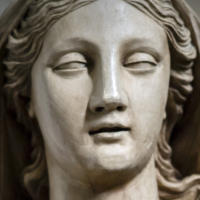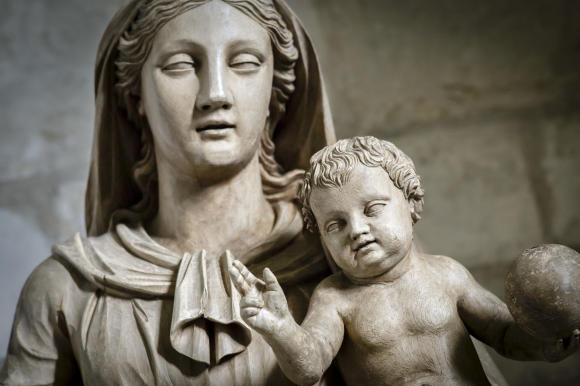
In an economic context that isn’t favorable to either culture or heritage sites, monetary prizes award for restoration of elements of local heritage go a long way towards uniting a village or a community around a common aspect of their history and enabling the transmission of those elements to future generations.
Many of those elements have their origins in the Catholic Church. Though France is a secular republic, it possess a rich Catholic heritage. As travelers, whether Catholic or of another faith or atheist, exploring that heritage can be as much a part of the pleasure and curiosity of visiting the French countryside as local food, wine and castles.
The Observatory of Religious Heritage, Observatoire du Patrimoine Réligieux, estimates that 100,000 edifices in France were originally constructed on behalf of religious organizations. About 15,000 are protected as historical monuments, with 94% of those being Catholic. Many of those are far off the beaten track. And the remaining tens of thousands and the treasures they hold are scarcely known beyond the community in which are they’re found. Among them are many paintings, sculptures, windows and altarpieces that, along with structure elements of the buildings themselves, are slowly, quietly decaying and in desperate need of restoration if they’re to be preserved. Due to their sheer quantity, however, many are ignored or simply deplored until a small group bands together to take on the mission of securing financing for their restoration and preservation. This often begins with the creation of a non-profit association, known in France as an Association Loi de 1901, the year that legislation on such associations was put in place.

Numerous small but passionate associations exist throughout France to preserve a wide array of edifices and works of art and of craft. To complement their meager resources for restoration projects, they seek funding from various levels of government (the primary source of “giving” in France), from cultural foundations and from other private sources.
Pelerin’s A Heritage for Tomorrow Prizes
One of those private sources is the French Catholic magazine Pèlerin (Pilgrim), which each November since 1990 gives a helping hand to a dozen or so projects through its “Un Patimoine pour demain” (A Heritage for Tomorrow) Prizes.
“A Heritage for Tomorrow” seeks to “encourage and assist the restoration of French cultural and religious heritage,” according to the prize application information. Pèlerin is particularly interested in transmitting that heritage to future generations—of the faithful, of course, and, potentially, to the wider community.
Transmission may be key here for religious purposes, yet while nearly all of the selected of structures and objects speak of Catholicism, they also tell of the artistry, craftsmanship, architecture, economics and historical events at the time of their creation. As such they have potential interest to foreign visitors who, during their off-track wanderings, may one day benefit, perhaps unwittingly, from the restorations of the 15th– and 16th-century frescoes at Notre-Dame-de-Assomption in Jandun (Ardennes) or the 17th-century statues in Notre-Dame de Chappes (Allier) or a painting of the Crucifixion of Saint Peter in the church of Vic d’Oust (Ariège) or the 19th barn near a church in Saint-Aupre (Isère) or any of the seven other projects recognized by Pèlerin’s 2012 prizes.
Admittedly, foreign travelers are unlikely to know where any of those places are, and it’s unlikely that a traveler would simply pass through any of these villages since many of them are far removed from the major routes of tourism. Nevertheless, these prizes are mentioned here not to encourage readers to seek them out in particular (though that’s not a bad idea) so much as to reminder them of what discoveries can be found by hitting the back roads of France, stopping in a village where nothing much seems to be happening, and getting curious: “Got heritage?”

The jury for these prizes is comprised of specialized curators, editors, journalists and the recipient of the previous year’s Young Artisan Prize, along with an honorary president, who this year (2012) was Franck Ferrand, a writer and radio personality focusing on history and heritage sites. The jury considers the feasibility of each applicant restoration project and the urgency of the situation and, perhaps most importantly, whether the project has local support and potential wider interest.
A total of 30,000€ was awarded in “Un patrimoine pour demain” prizes in 2012, including several prizes given in partnership with other associations and publications interested in specifically Catholic issues or rural preservations. Ranging from 2200 euros ($2860) to 10,000 euros ($13,000), the individual award amount may not fully fund the selected work, but it allows a project to go forward since this financial support that can help close a budget and provide moral support that encourages local interests to pursue their cause.
Twelve prizes were given this year in ten categories, seven involving restorations (chapels, frescoes, statuary, civil buildings, paintings, furnishings, stained glass), one for a creation, one for some aspect of a new religious edifice, and one for a young artisan. This year’s prizewinning artisan is Fanny Kurzenne, who specializes in the restoration of works in stone and also has an interest in polychromy and the preservation of 19th-century plaster copies.
Images and descriptions of the all of the prize winners can be found on Pèlerin’s website (in French). The site also has a video of the 2-hour awards ceremony which was held this year at the Cité de l’Architecture et du Patrimoine in Paris.
Cigale TV’s Living Treasures of Craftsmanship Trophies
Less spectacular than the ceremonies organized by Excellence Française or Pelerin, Cigale TV’s Trophées des trésors vivants de l’artisant (Living Treasures of Craftsmanship Trophies) honor the pursuit, continuity and transmission of little-used but high-quality know-how in various fields of craftsmanship that the award committee considers as specifically French.
The three winners were received their trophies in a ceremony that took place during this year’s International Heritage Show at the Carrousel de Louvre in Paris:
1. Eric Hamers, diamond cutter,
2. Patrick Sébille, mattress maker, and
3. Vittorio Sério, furniture maker/designer.
Two honorary mentions also receiving trophies were:
4. Bernard Dauvet, gold beater, and
5. Jean Michel Desisle, bronze maker.
These five winners were selected out of 20 nominees by eight jurors involved various fields of craftsmanship along with the editor of Cigale TV. Cigale TV, “La télé des savoir-faire,” presents and promotes various types of craft, craftsmanship and know-how.
A sixth aware by public vote on the Cigale website went to Vincent Rivalin, maker of “charentaise” slippers and clogs.
The winning craftsmen are shown practicing their work in their workshops or factories in videos seen here.
Living Heritage Companies
A company itself can join the ranks of an element of French heritage if over 100 years old. It can then receive the label “Entreprise de patrimoine vivant” (Living Heritage Company) from the Finance Ministry.
 The directory lists companies chronologically beginning with Prat Dumas, which has been making paper filters since 1460, La Rochère SAS, which has been making glassware since 1475, Saint-Louis, which has been making crystal since 1586, and Poteries des Anduze, creators of ornamental pottery since 1610. The longevity of three of the companies honored this year by Excellence Française, examined in Part 1 of this article—Aubusson (tapestries), Pleyel (pianos) and Chistophle (silverware)—have earned them the label.
The directory lists companies chronologically beginning with Prat Dumas, which has been making paper filters since 1460, La Rochère SAS, which has been making glassware since 1475, Saint-Louis, which has been making crystal since 1586, and Poteries des Anduze, creators of ornamental pottery since 1610. The longevity of three of the companies honored this year by Excellence Française, examined in Part 1 of this article—Aubusson (tapestries), Pleyel (pianos) and Chistophle (silverware)—have earned them the label.
The Institut Supérieur des Métiers (Superior Institute of Trades) has compiled a directory of 314 secular companies that are over 100 years old, some of them in the same family for generations.
The full directory can be viewed online here.
© 2012, Gary Lee Kraut
Return to Part 1 of Paris Award Ceremonies Honor French Excellence, Heritage and Savoir-Faire.

